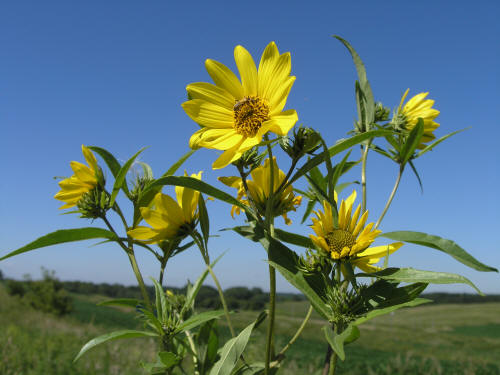Go to Midwest Weeds and Wildflowers Home Page
(updated May 10, 2021)
Perennial Sunflowers
Helianthus spp.
Asteraceae (Aster Family)

▲▼ flowering perennial sunflower (Sawtooh Sunflower)

PERENNIAL SUNFLOWERS:
·
Include
Ashy
Sunflower,
Texas Blueweed,
Maximilian Sunflower,
Sawtooth Sunflower,
Western Sunflower,
Willowleaf Sunflower,
Jerusalem Artichoke,
and other species
·
All are creeping perennial weeds that form rhizomes and/or creeping
roots that allow them to spread to form colonies with maturity
·
Most are palatable to livestock, except in fertile soils, where high
nitrate accumulation may cause poisoning, but may be seen as weedy in
reduced tillage crops
·
Once established, these species can be hard to
control, but
most
(not all) are not considered to be weedy
·
Most produce relatively tall (4-8 feet tall or more), unbranched,
leafy stems with linear, lanceolate to ovate/triangular, rough-textured
leaves; upper stem portions are usually branched with the onset of
flowering, so that each branch stem tip has a flower head
·
Flowers for most perennial sunflowers quite similar (with some
exceptions); they are in terminal clusters, flowering usually sometime from
mid-summer to late autumn, with yellow ray flowers and yellow to brown disk
flowers; total flower diameter is usually 2-4 inches
o
Perennial sunflower “flowers” are usually
smaller than annual sunflower “flowers,” such as with
Annual
Sunflower (Helianthus
annuus)
or
Prairie
Sunflower (Helianthus
petiolaris)
·
Usually, it is more of the stem and leaf characteristics that are
used to identify the different perennial sunflower species
·
Click
on
links
of above individual plant names to see more information on each one
Most
perennial sunflowers are native plants that usually do not cause harm in
grazing or haying situations (maybe with the exception of the more weedy
Texas Blueweed).
Perennial sunflowers provide
food and nectar for native insects (including bees and butterflies),
birds and other animals, and generally should not be killed
indiscriminately.
Maintaining proper grazing
levels can often reduce their unwanted increase in pastures and
rangeland.
Go to Midwest Weeds and Wildflowers Home Page